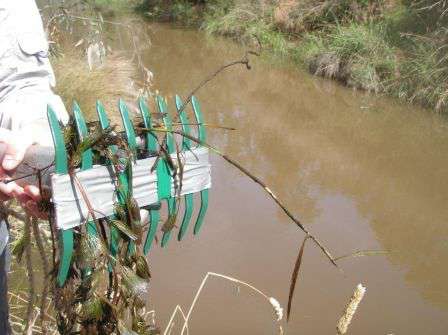The Goulburn Broken Catchment Management Authority (CMA) and the Benalla Rural City Council (BRCC) are encouraging the local community and visitors to assist in the identification of Cabomba populations and report back to the agencies.
The Goulburn Broken Catchment Management Authority (CMA) and the Benalla Rural City Council (BRCC) are encouraging the local community and visitors to assist in the identification of Cabomba populations and report back to the agencies.
Wayne Tennant Manager Strategic River Health said "Both agencies are keen to continue their efforts to prevent the spread of one of the most invasive aquatic weeds in Australia."
Cabomba, which is located within Lake Benalla and immediately downstream in the Broken River to Casey's Weir, has potential to impact on other waterways and water bodies should it be transported by either stream flow or unintentional human activities.
"Both the Goulburn Broken CMA and BRCC are encouraging anyone who think they have seen Cabomba to report the location. The known locations of Cabomba are within Lake Benalla and the Broken River down to Caseys Weir" said Wayne Tennant.
The work undertaken over the past three years has seen a dramatic reductio in the weed but we need to ensure that other populations do not exist, which may increase the population if left unmanaged.
Mr Tennant said "Cabomba, which is native to South America, is regarded as one of the worst weeds in Australia because of its invasiveness, potential for spread, and economic and environmental impacts".
Cabomba is an underwater plant that is described by slightly flattened stems that arise from the base of the plant. Its leaves are on opposite sides and fan-shaped. The leaves can also be described as being soft, and flexible. The flowers of Cabomba are located just above the water surface when they are fully open. Each flower has three petals that are pink to yellow, and may be spotted. Each flower is approximately 10mm wide.
"The Goulburn Broken CMA and BRCC have been working in partnership with the Department of Primary Industries, Goulburn-Murray Water and the Federal Government's Caring for Our Country initiative to reduce the spread and impact of the Lake Benalla incursion over a number of years" said Mr Tennant. "But we also need to reduce the potential for its movement by human activity."
Cabomba is frequently used in fish tanks and aquariums as an attractive leaved water plant that is fast-growing – so if you do not wish to keep your fish tank please dispose of the fish and vegetation appropriately. You can dispose of aquatic plants by drying them in the sun and putting them in a plastic bag to dispose of in the rubbish. If you are unsure contact your local Department of Primary Industries office on 136 186.

Photo: cabomba caught using a rake throw in the Benalla area. Photo: Jamie Kaye water Technology
To find out more about the Goulburn Broken CMA and its programs please visit www.gbcma.vic.gov.au or phone 03 5820 1100.